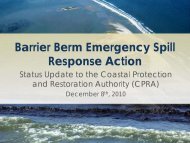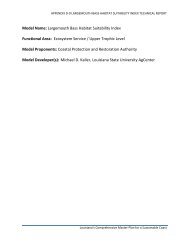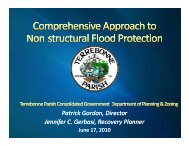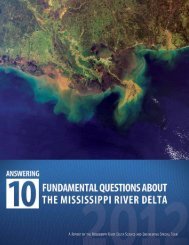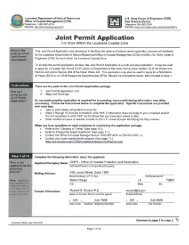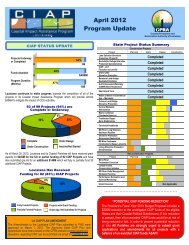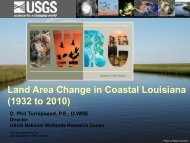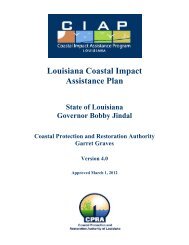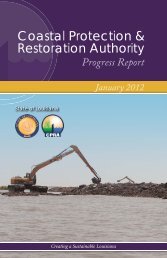barrier island status report - Coastal Protection and Restoration ...
barrier island status report - Coastal Protection and Restoration ...
barrier island status report - Coastal Protection and Restoration ...
Create successful ePaper yourself
Turn your PDF publications into a flip-book with our unique Google optimized e-Paper software.
Habitat analysis based on the aerial photography is complete. Detailed habitat data for all BICM<br />
shoreline areas are available for 1996/98, 2002, 2004, <strong>and</strong> 2005 along with change maps<br />
showing habitat differences for all time periods (Figures 11 <strong>and</strong> 12).<br />
Collection of surficial sediments for sediment characterization was conducted in 2008 <strong>and</strong><br />
analysis is complete. Sediment characterization analysis, <strong>report</strong>s, <strong>and</strong> distribution maps are<br />
available (Figure 13).<br />
Analysis <strong>and</strong> final <strong>report</strong> preparation is ongoing through USGS <strong>and</strong> publication of an USGS<br />
open file <strong>report</strong> (Baldwin et al., 2009) should be completed in early 2013. Planning <strong>and</strong> design<br />
of the program will continue to refine future data collection, analysis, products, tools, <strong>and</strong><br />
timelines for future programmatic monitoring.<br />
CIAP funded monitoring of vegetation on some <strong>barrier</strong> <strong>isl<strong>and</strong></strong> projects will be used to refine<br />
vegetative sampling procedures proposed in the original 2003 BICM proposal document. These<br />
vegetative sampling procedures will be conducted <strong>and</strong> analyzed to determine the added value of<br />
vegetative sampling within the BICM program, <strong>and</strong> potential costs of full-scale implementation.<br />
Once this analysis is completed, decisions will be made whether to incorporate this additional<br />
BICM component as originally recommended.<br />
The next BICM Program data collection will be initiated in 2013 beginning with updated<br />
shoreline change <strong>and</strong> habitat analysis using the 2012 CRMS coastal photography recently<br />
collected. Work plans <strong>and</strong> contracts are currently being finalized to repeat other data collection<br />
activities along the coast over a four-year period, as well as exp<strong>and</strong> collection to areas not<br />
covered initially (Figure 14).<br />
3.2 Monitoring of the Emergency Berms<br />
In response to the Deepwater Horizon oil spill which began on April 20, 2010, the State of<br />
Louisiana constructed approximately 16 miles of s<strong>and</strong> berms along several sections of the State‟s<br />
<strong>barrier</strong> <strong>isl<strong>and</strong></strong>s both east <strong>and</strong> west of the Mississippi River. The objective of this project was to<br />
provide a <strong>barrier</strong> to oil <strong>and</strong> minimize the potential impact of the oil spill to thous<strong>and</strong>s of acres of<br />
fragile <strong>barrier</strong> <strong>isl<strong>and</strong></strong>s <strong>and</strong> wetl<strong>and</strong>s in coastal Louisiana. These berms are man-made features,<br />
were constructed for a specific purpose, as stated above, <strong>and</strong> are different geomorphologically<br />
than native <strong>barrier</strong> <strong>isl<strong>and</strong></strong>s. However, we gain significant insight into coastal processes which<br />
effect <strong>barrier</strong> <strong>isl<strong>and</strong></strong>s by monitoring their changes over time.<br />
On May 27, 2010, a NOD‐20 emergency permit (MVN 2010‐1066‐ETT) was issued by the U.S.<br />
Army Corps of Engineers (USACE), New Orleans District (CEMVN). The emergency permit<br />
allowed the construction of s<strong>and</strong> berms in specified areas or “reaches”. Specifically, reaches E3<br />
<strong>and</strong> E4 to the east of the Mississippi River, <strong>and</strong> reaches W8, W9, W10, <strong>and</strong> W11 to the west of<br />
the Mississippi River, were authorized for a total of approximately 38 miles of <strong>barrier</strong> berm.<br />
These areas were identified by USACE staff as critical locations where greater immediate benefit<br />
was likely to be achieved with minimal adverse disruption of the coastal environment. Only<br />
18 | P a g e



